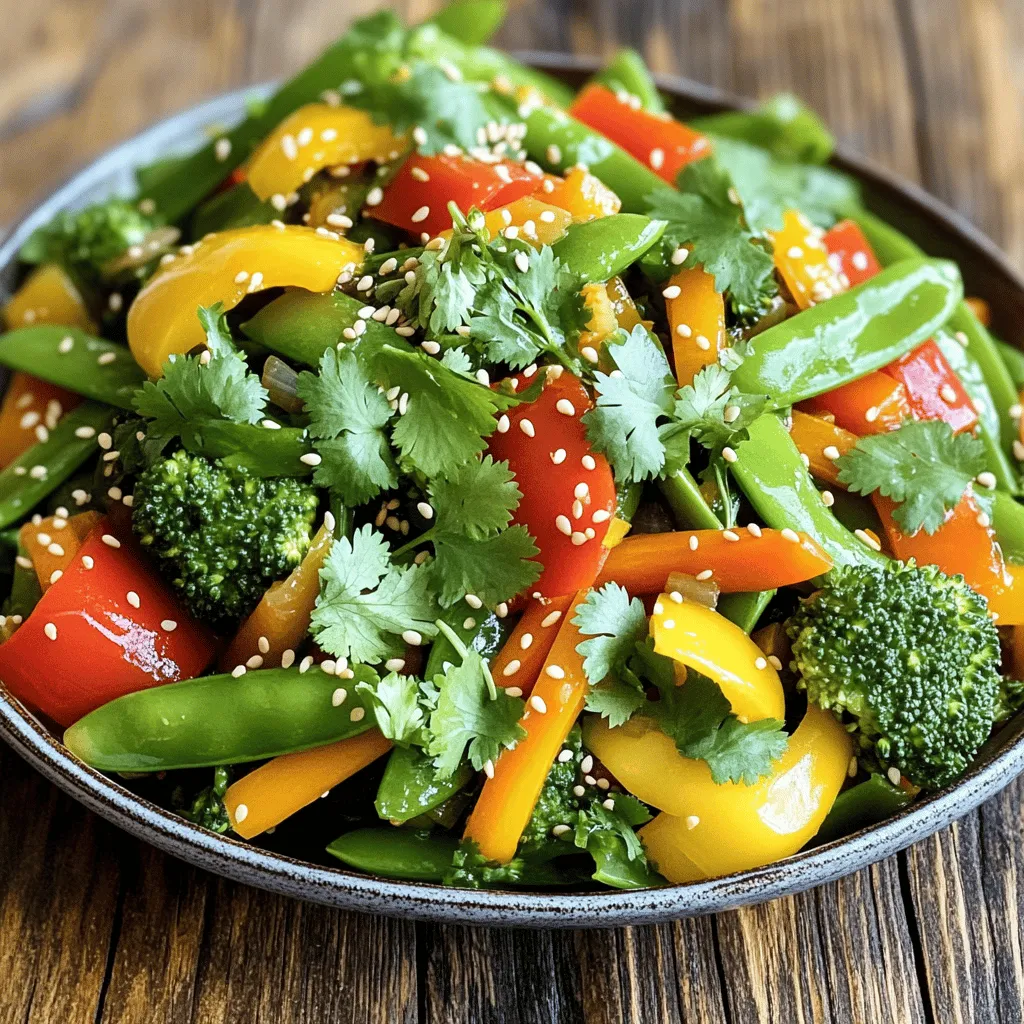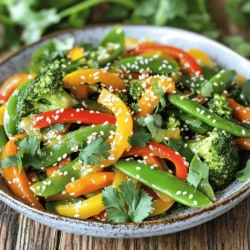Are you ready to whip up a tasty meal in just 20 minutes? This Easy Vegetable Stir-Fry is packed with flavor and good for you! I’ll show you how to choose the best veggies, season them perfectly, and avoid common mistakes. Whether you’re a cooking novice or a kitchen pro, you’ll love this simple guide. Let’s dive into the fresh, delicious world of stir-frying!
Ingredients
Essential Vegetables for Stir-Fry
For a great stir-fry, you need fresh vegetables. Here are my favorites:
– 1 cup bell peppers (red, yellow, and green), sliced
– 1 cup broccoli florets
– 1 cup snap peas
– 1 medium carrot, julienned
These veggies give color and crunch. They cook quickly and taste great together.
Optional Ingredients for Added Flavor
You can add even more to your stir-fry for extra taste. Here are some options:
– Sliced mushrooms
– Zucchini, cut into half-moons
– Baby corn
– Bok choy
These ingredients can change the flavor and feel of your dish. Feel free to mix and match!
Recommended Seasonings and Sauces
Seasoning is key to a fantastic stir-fry. I recommend using:
– 2 cloves garlic, minced
– 1 tablespoon fresh ginger, grated
– 3 tablespoons soy sauce (or tamari for gluten-free)
– 1 tablespoon sesame oil
– 1 tablespoon olive oil
– 1 teaspoon honey or maple syrup (optional for sweetness)
These seasonings add depth and richness. They make your stir-fry flavorful and exciting!
Step-by-Step Instructions
Preparing Your Vegetables
Start by washing all your vegetables. Use cold water to rinse each one. For this stir-fry, you need bell peppers, broccoli, snap peas, and carrots. Slice the bell peppers into thin strips. Cut the broccoli into small florets. Julienne the carrot into thin sticks. Keep all the vegetables on a cutting board. This makes it easy to grab them when you need.
Sautéing Techniques
Heat a large skillet or wok over medium-high heat. Add olive oil and sesame oil to the pan. Wait until the oils shimmer. Now, it’s time to add minced garlic and grated ginger. Stir them quickly for about 30 seconds. Be careful not to burn them, or they will taste bitter.
How to Properly Add and Coat Ingredients
Begin with the bell peppers and carrots. They take longer to cook. Stir-fry these for about 2-3 minutes. Next, add the broccoli and snap peas. Continue to stir-fry for another 3-4 minutes. Your goal is to keep the vegetables vibrant and crisp. Once they are tender, pour in the soy sauce. If you want some sweetness, add honey or maple syrup. Toss the vegetables to coat them evenly. Cook for one more minute to heat through. Now, your dish is ready to serve!
Tips & Tricks
Ensuring Perfectly Cooked Vegetables
To get the best stir-fry, cut your veggies small. This helps them cook fast. I like to keep them colorful. Use red, yellow, and green bell peppers. They add flavor and look great. Always heat your oils until they shimmer. This step makes sure your stir-fry cooks evenly.
Common Mistakes to Avoid
One big mistake is crowding the pan. If you add too many veggies at once, they will steam instead of fry. Cook in batches if needed. Also, avoid cooking on low heat. Stir-frying needs high heat to keep the veggies crisp. Lastly, don’t forget the garlic and ginger. They add a lot of flavor if you cook them right.
Time-Saving Tips for Quick Cooking
Prep is key for quick cooking. Chop all your veggies ahead of time. Store them in the fridge until you are ready to cook. You can even use frozen vegetables. They are handy and save time. Another tip is to have your sauce ready before cooking. This way, you can add it quickly and keep the process moving.

Variations
Protein Additions for a Heartier Meal
You can boost your stir-fry with protein. Options like chicken, shrimp, or tofu work well. Simply cook the protein before adding the vegetables. For chicken or shrimp, cut them into small pieces. Cook them in the pan until they turn golden. Then, remove them and add the veggies. If you use tofu, press it to remove water. Cube it and sauté until crispy. This adds great texture and makes your dish more filling.
Alternative Vegetable Combinations
Feel free to mix and match vegetables. The key is to use what you love. Try zucchini, mushrooms, or bok choy for variety. These choices bring unique flavors and textures. You can also use root veggies like sweet potatoes or parsnips. Just remember to slice them thin to cook fast. The more colors you add, the better it looks and tastes. It’s not just healthy; it’s fun!
Seasonal Variations and Substitutions
Take advantage of seasonal produce. In spring, use asparagus and snap peas. Summer calls for fresh corn and tomatoes. Fall is perfect for squash and kale. In winter, use hearty vegetables like Brussels sprouts and carrots. These choices pack in flavor and nutrition. Always check your local market for what’s fresh. This ensures your stir-fry is tasty and supports local farmers.
Storage Info
Best Practices for Refrigerating Leftovers
To store your leftover vegetable stir-fry, let it cool down first. Place it in an airtight container. This keeps it fresh and tasty. You can keep it in the fridge for up to three days. When you’re ready to eat it, check for any signs of spoilage. If it looks good, you’re all set!
How to Freeze Vegetable Stir-Fry
Freezing vegetable stir-fry is a great way to save it for later. First, let it cool completely. Then, pack it tightly in freezer-safe bags. Make sure to squeeze out as much air as possible. Label the bags with the date. You can freeze it for up to three months. When you want to use it, simply thaw it in the fridge overnight.
Reheating Tips for Maintaining Flavor and Texture
To reheat your stir-fry, use a skillet or a wok. Heat it on medium heat. Add a splash of water or broth to keep it moist. Stir it often to avoid burning. This method helps keep the veggies crisp and vibrant. You can also use a microwave if you’re short on time. Cover the dish to trap steam, but don’t forget to stir halfway through. Enjoy your flavorful meal just like the first time!
FAQs
What vegetables are best for stir-fry?
For a great stir-fry, use crisp and colorful veggies. My favorites include:
– Bell peppers
– Broccoli florets
– Snap peas
– Carrots
These veggies cook fast and stay crunchy. You can mix any vegetables you like. Just remember to cut them into similar sizes for even cooking.
Can I make this stir-fry vegan?
Yes! This stir-fry is easy to make vegan. Just use tamari instead of soy sauce. You can skip the honey or use maple syrup for sweetness. All the veggies are plant-based. So, it’s perfect for everyone.
How long can I store leftover vegetable stir-fry?
You can store leftover stir-fry in the fridge for up to four days. Keep it in an airtight container. When you want to eat it, just reheat in a skillet or microwave. This will help keep the flavors fresh.
Stir-frying is a fun and fast way to cook. We explored key veggies, sauces, and techniques. Proper prep and cooking help keep veggies crisp. Avoid common mistakes for the best taste. You can mix colors and flavors, too, to fit the season.
Finally, store leftovers well to keep them fresh. Enjoy your tasty stir-fry adventures, and remember, practice makes perfect!


